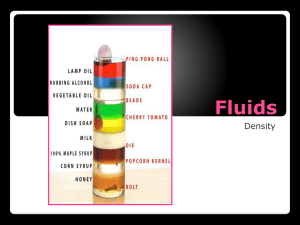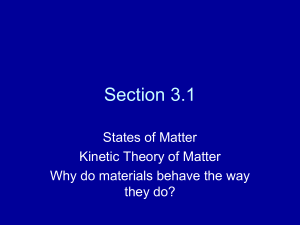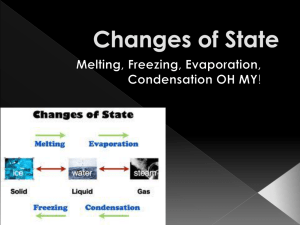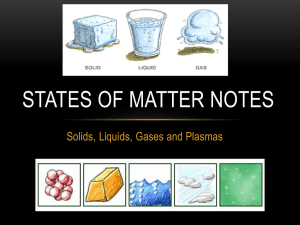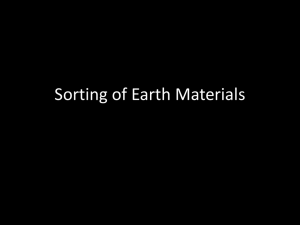8I Heating and Cooling quiz
advertisement
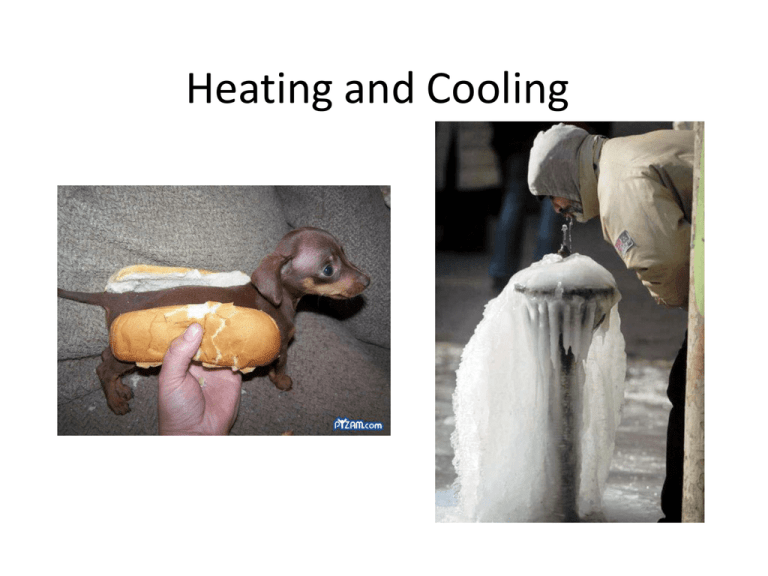
Heating and Cooling 1. Another name for heat energy is: 1. 2. 3. 4. kinetic energy. spring energy. thermal energy. mechanical energy. 94% 6% 1 0% 2 0% 3 4 2. What are the units for measuring heat energy? 1. 2. 3. 4. newtons degrees Celsius Joules degrees Fahrenheit 47% 35% 18% 0% 1 2 3 4 3. If you leave a cup of hot tea standing in the kitchen for a whole day, what will happen to its temperature? 1. It will stay the same. 2. It will get only a little bit cooler. 3. It will end up the same temperature as the air in the kitchen. 4. It will be colder than the air in the kitchen. 71% 29% 0% 1 0% 2 3 4 4. The amount of heat energy in an object depends on three things. Which of these things does it not depend on? 1. 2. 3. 4. its mass its colour its temperature the material it is made from 47% 18% 1 18% 2 3 18% 4 5. Which of these materials is a good conductor of heat? 1. 2. 3. 4. copper air water glass 71% 18% 6% 1 2 6% 3 4 6. When one end of a piece of metal is heated: 1. the particles get closer together. 2. the particles vibrate more and the vibrations are passed from particle to particle. 3. the heat does not move through the metal. 4. the particles get bigger. 41% 29% 24% 6% 1 2 3 4 7. Solids are better conductors than liquids or gases because: 1. the particles are closer together in gases. 2. the particles are closer together in liquids. 3. the particles are closer together in solids. 4. the particles in a solid cannot move. 47% 29% 18% 6% 1 2 3 4 8. Feathers are good insulators because: 1. they are solid. 2. birds have them. 3. they trap pockets of air. 4. they are waterproof. 71% 18% 6% 1 6% 2 3 4 9. Why do materials expand when they are heated? 1. The particles get bigger. 2. The particles move around more and take up more space. 3. The particles get closer together. 4. The particles stick together. 35% 35% 18% 12% 1 2 3 4 10. Which substances can heat travel through by convection? 1. 2. 3. 4. solids and liquids solids and gases only liquids liquids and gases 41% 29% 24% 6% 1 2 3 4 Participant Scores 8 Zoe Benton 7 7 6 6 Emma Weeks Emma Fosh Sarrah Turner Alexander Thompson 11. Why does the cold air near the ice lolly move downwards? 1. It is colder and denser than the air near it. 2. It is warmer and denser than the air near it. 3. It is colder and less dense than the air near it. 4. It is warmer and less dense than the air near it. 53% 47% 0% 1 2 0% 3 4 12. Infrared radiation can travel through: 1. transparent objects only. 2. opaque objects only. 3. empty space only. 4. empty space and transparent objects. 41% 24% 24% 2 3 12% 1 4 13. Why do we need to save energy? 1. Fossil fuels are running out. 2. Renewable energy resources are running out. 3. To pay for insulation. 4. Renewable energy is cheap. 71% 29% 0% 1 2 3 0% 4 14. Loft insulation is used: 1. to keep the loft warm. 2. to keep heat energy in the house. 3. to stop the roof from being covered with snow. 4. to protect the rafters. 94% 6% 1 0% 2 3 0% 4 15. Houses can lose heat energy through: 1. 2. 3. 4. the walls. the floors. the windows. all of the above. 47% 41% 6% 1 6% 2 3 4 16. Duvets and loft insulation are good insulators because: 1. they are soft. 2. they do not cost very much. 3. they last a long time. 4. they contain trapped air. 94% 0% 1 0% 2 6% 3 4 17. When liquid water changes into steam it is: 1. 2. 3. 4. condensing. evaporating. melting. dissolving. 94% 6% 1 0% 2 3 0% 4 18. Candle wax melts at 57 ºC. At what temperature does candle wax freeze? 1. 2. 3. 4. 0 ºC 7 ºC 57 ºC 100 ºC 35% 29% 18% 1 2 3 18% 4 19. What happens to the temperature of the water in a beaker when it is boiling? 1. 2. 3. 4. It goes up. It stays the same. It goes down. It all depends on how hot the water was to start with. 47% 35% 12% 6% 1 2 3 4 20. When molten wax is freezing and turning back into a solid, what happens to the temperature of the wax? 1. 2. 3. 4. It goes up. It stays the same. It goes down. It all depends on how hot the wax was to start with. 65% 24% 6% 1 6% 2 3 4 Participant Scores 16 Emma Weeks 15 14 13 13 Zoe Benton Emma Fosh Sarrah Turner Yasmine Islam


